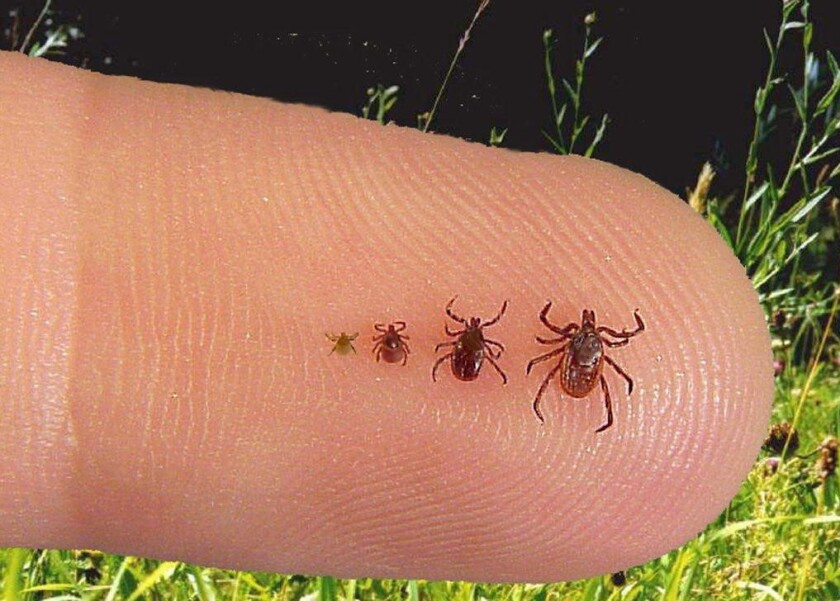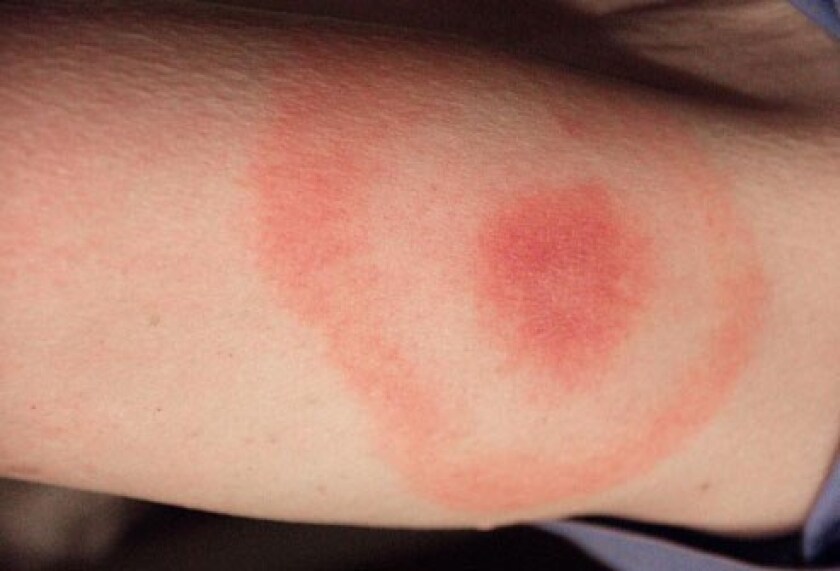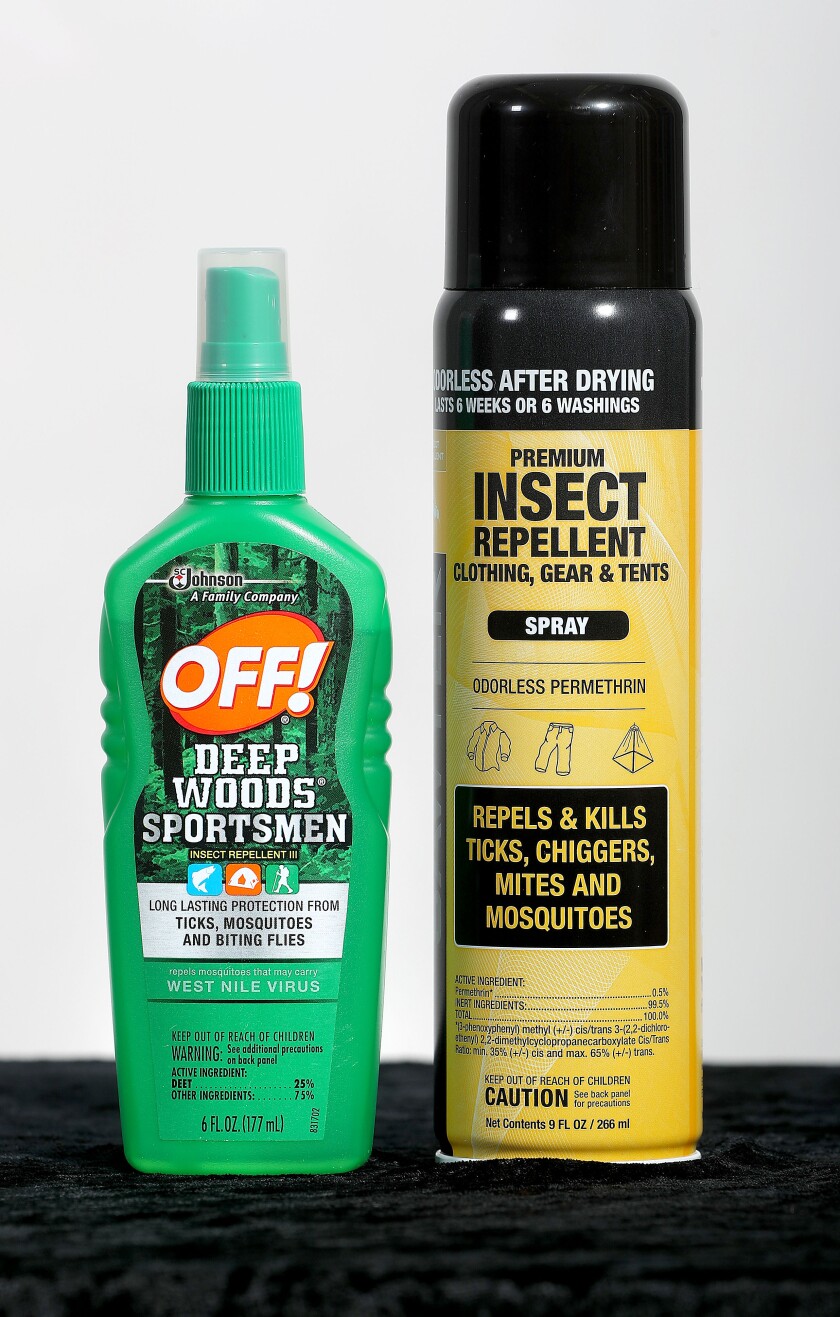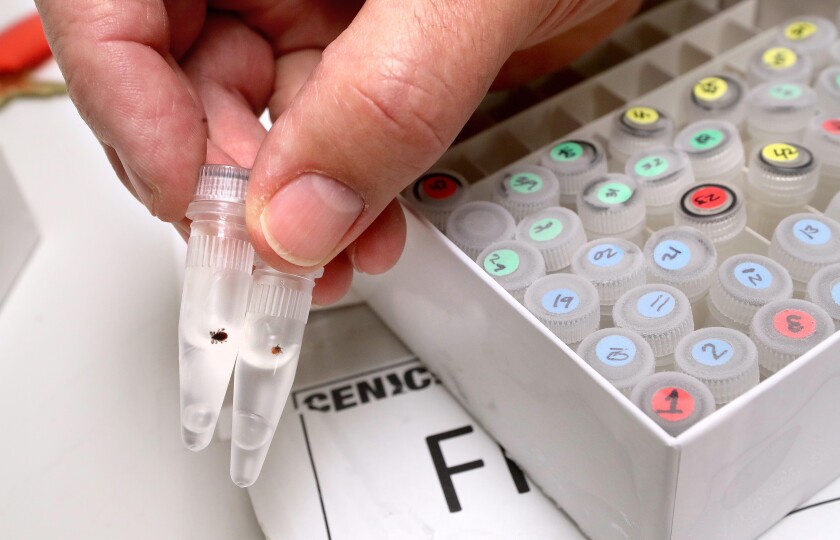Everything you need to know about ticks (and the diseases they carry that can make you very sick) - Duluth News Tribune
DULUTH — Lyme disease has been identified for nearly 50 years now, and it's been increasing across the Northland for more than half that time.
And while the name of the tick most notorious for carrying the disease has been changed, and even though there are now another half-dozen tick-borne diseases we know to be concerned about, many people who spend time outdoors still aren't taking the situation seriously enough to protect themselves.
Because blacklegged ticks, formerly called deer ticks, like damp conditions and mild winters, last year's drought, coupled with this winter's colder-than-normal temperatures, might mean fewer ticks in the region this spring and summer. But they will still be there, and recent research shows more than half of them are carrying bacteria that causes Lyme disease.
So here's a compilation of the latest information we've found on what ticks and tick-borne diseases are out there, and what you can do to keep yourself from getting very sick.

Contributed / Centers for Disease Control and Prevention
ADVERTISEMENT
No snow, ticks start to go
Ticks are out as soon as the snow melts. Each morning, they crawl out of the damp leaves and duff on the ground, up onto a blade of grass, flower or a weed, stick their arms out and wait for a warm-bodied host to walk past.
While ticks are already out, and people may already be exposed to tick-borne disease if they spend time outdoors in spring — turkey hunters, mushroom pickers and hikers — it's not until June, July and August that the number of cases of tick-borne illness increases dramatically in the Northland as more people are outdoors during the warmest months. Cases pick up again in fall and can continue into November during years with warm autumns.

Contributed / California Department of Public Health
Blacklegged ticks and Lyme disease
Lyme disease is an infection caused by the bacteria borrelia burgdorferi. This spiral shaped bacterium is spread by the bite of a blacklegged tick, formerly called deer ticks. The disease is named after Lyme, Connecticut, where it was first identified in the U.S. in 1975.
Blacklegged ticks can bite and spread disease in all of their life stages, including tiny nymphs in spring and adults in fall. For a month or so after a known tick bite, watch for symptoms including a red spot (often shaped like a bullseye) or rash near the bite site, full body rash, neck stiffness, headache, nausea, weakness, muscle or joint pain or aches, fever, chills, and swollen lymph nodes. Some victims have reported mood changes, vision problems, cognitive issues and even sleep disorders and heart problems. In some cases, severe arthritis symptoms occur, as do Bell's palsy nerve issues.

Contributed / U.S. National Park Service
Other tick-borne diseases
- Anaplasmosis: Also spread by blacklegged ticks, a bacterial disease that can cause fever, severe headache, muscle aches, chills and shaking as well as nausea, vomiting, weight loss, abdominal pain, diarrhea and mental fatigue. Tends to be most severe in the aging or immune-compromised. Severe complications can include respiratory failure, renal failure and secondary infections.
- Babesiosis: Also spread by blacklegged ticks, a rare and life-threatening infection of the red blood cells caused by tiny parasites called babesia. Previously found only on the East Coast and California, it has been confirmed in Minnesota and Wisconsin. Signs of babesiosis start one to eight weeks after a tick bite. Symptoms include body aches, chills, fatigue, fever, headache, loss of appetite and sweating. You also can get a condition called hemolytic anemia in which your red blood cells die faster than your body can make new ones.
- Powassan encephalitis: Also spread by blacklegged ticks (and squirrel ticks and groundhog ticks), symptoms include fever, headache, vomiting and weakness. Can cause severe disease, including infection of the brain, encephalitis, or infection of the membranes around the brain and spinal cord, meningitis, which can cause confusion, loss of coordination, difficulty speaking and seizures. About 1 out of 10 people with severe disease die and half who survive severe disease have long-term health problems such as recurring headaches, loss of muscle mass and strength and memory problems.
- Ehrlichiosis: Spread by blacklegged ticks and lone star ticks, caused by the bacteria Ehrlichia chaffeensis, E. ewingii or E. muris eauclairensis. Symptoms include fever, chills, headache, muscle aches and sometimes upset stomach.
- Alpha-gal syndrome (also called alpha-gal allergy, red meat allergy or tick bite meat allergy): Spread by the lone star tick. It is a serious, potentially life-threatening allergic reaction, not an infection. Symptoms occur after people eat red meat and include hives or rash; nausea or vomiting; heartburn or indigestion; diarrhea, cough, shortness of breath or difficulty breathing; drop in blood pressure; swelling of the lips, throat, tongue or eyelids; dizziness or faintness; and severe stomach pain.
- Rocky Mountain spotted fever: Spread by wood ticks, also called dog ticks, a bacterial disease that causes fever, headache and rash. Can be deadly if not treated early with the right antibiotic. The number of cases has risen in the last two decades, from 495 cases in 2000, to a peak of 6,248 in 2017. It has been confirmed in Minnesota and Wisconsin and is more common in the Dakotas.

Bob King / 2018 file / Duluth News Tribune
Protect yourself
Experts strongly suggest using both a personal insect repellent on your skin as well as a repellent that can be applied to clothing.
ADVERTISEMENT
- DEET: By far the most effective insect repellent, including for keeping ticks away. Multiple studies have found that, in concentrations of 30 percent and under, it's considered safe to use on human skin. Other options include picaridin, a synthetic compound first made in the 1980s to resemble the natural compound piperine, found in the plants that produce black pepper.
- Permethrin: Keep off skin but spray on clothing, or soak clothing in permethrin, to keep ticks and other insects at bay for long periods, often several washes. Considered extremely effective and also works to keep away mosquitoes that may be carrying viruses like West Nile, zika and malaria where that occurs.
- Clothing: Ticks usually crawl onto people below the knees and then crawl upward. Wear long-sleeved shirts and long pants. Wear light-colored clothes so it is easier to see ticks. Tuck pants inside socks to keep them on the outside of your clothing, giving you more time to see and remove them before they get to your skin and start feeding.
- At least one company, insectshield.com , sells clothing pretreated with permethrin that is said to last much longer. You can also send your clothes to the company to be treated.
- Tick check: Experts suggest checking yourself in front of a mirror after coming in from outdoors, or better yet, have someone else help check you. Hotspots are around the waist, under the arms, inner legs, behind the knees and around the head, including in and around the ears and in the hair. Adults should help check their young children for ticks.
- Take a shower. The force of the water running over you will help wash off any unattached ticks you can't see. Simply submerging the ticks in water for a short time, say in a bath or taking a swim, doesn't necessarily kill them.
- Remove ticks: Prompt removal of embedded ticks helps reduce the chance a disease will be transmitted. Ticks need to be attached for six to 24 hours to transmit disease to humans. The best method for removing a feeding tick is to grasp it as close as possible to the skin of the host with tweezers or tissue paper. Do not squeeze the tick if possible. Gently, yet firmly, apply steady pressure on the tick until you pull it out. If you try to jerk or twist the tick out, you risk the mouth parts breaking off and remaining in the skin. Clean out the wound with a good germicidal agent, such as iodine, to help prevent infection. (Experts say using tape, alcohol or Vaseline to cover the tick and cause it to voluntarily pull its mouth parts out of the skin is ineffective.)
- Save ticks: If there is any question as to whether this tick is a species that can potentially transmit disease, especially blacklegged, save it by placing it in a small container to be identified later.
- Call your doctor if you experience symptoms or if you are bitten by multiple ticks in a short time even without symptoms. The good news is that even the most serious cases can be treated, and patients get better, with antibiotics.
- Doxycycline can be a lifesaver: Several doctors suggest having a single, 1,000 milligram dose of doxycycline on hand to take if you are bitten by a blacklegged tick, especially if you spend a lot of time in tick-infested areas and expect to be away from medical care. The single dose is often effective at preventing tick-borne disease from taking hold.
- Dogs also are susceptible to several tick-borne illnesses, including ehrlichiosis, Lyme disease, anaplasmosis and others. Most veterinarians suggest using a medication such as Frontline, K9-Advantix or Vectra 3D or a tick collar. Many vets also suggest getting dogs vaccinated against Lyme disease.

Contributed / U.S. National Park Service
Who gets sick from ticks in Minnesota?
- 62% of tick-borne illness victims are male.
- Average age is 49.
- 61% experienced symptoms in June or July, which corresponds with the most active period for blacklegged ticks (May-August).
- More than half the cases either lived in or recently spent time outdoors in the most tick-prone areas of eastern Minnesota or western counties in Wisconsin.
Did you know?
- A blacklegged tick in its resting mode may take only one breath per day while waiting for a blood meal.
- Ticks sense your presence, and wake up quickly, by the carbon dioxide you exhale and your body heat.
- A female blackelgged tick may lay up to 4,000 eggs in the fall, but only about 5% will live long enough to take a blood meal the next spring.
- Ticks are born sterile and pick up diseases from small critters such as field mice. Higher rodent populations often mean more ticks and more tick-borne disease.
- Blacklegged ticks need a blood meal during each of their nymph, juvenile and adult stages of life.
Nearly half-million people treated for Lyme annually
Confirmed cases of Lyme disease in Minnesota jumped from an average of 913 each year in the 2000s to an average of 1,203 cases each year in the 2010s, a 32% increase, according to the Minnesota Department of Health.
Nationally, reported cases of diseases caused by tick bites rose from 22,527 in 2004 to 50,865 in 2019, the most recent year complete data is available for, according to the Centers for Disease Control and Prevention. But many experts say the actual number is far higher because many cases go officially unreported. As many as 476,000 people are reported treated for Lyme each year, up 56% from a decade ago.
Not only are more people being diagnosed with tick-borne diseases, as Northlanders and their doctors become more aware of the risks and symptoms, but more ticks in more places across the region are carrying disease. Doctors who specialize in tick diseases say that any bite from a blacklegged tick should be treated as if it's assumed the tick is carrying Lyme disease.
Blacklegged ticks also have expanded across the entire region, and anyone who spends time outdoors is vulnerable to a tick bite.

Contributed / Maryland Department of Natural Resources
Blame mice, and birds, not deer
While the bacteria that causes Lyme is present in small mammals like mice everywhere, there is something unusually conductive in the saliva in the blacklegged tick that can transmit it to people. It's the only tick that can do it, and scientists aren't sure why.
Blacklegged ticks were once commonly called deer ticks. But a better nickname would have been mouse ticks. According to several studies, the number of white-footed field mice around is a good indicator of how much tick-borne illness is around.
ADVERTISEMENT
"People living in northern and central parts of the U.S. are more likely to contract Lyme disease and other tick-borne ailments when white-footed mice are abundant," a study in the journal Ecology noted. "Mice are effective at transferring disease-causing pathogens to feeding ticks."
Fluctuations in mouse populations — due to predators, food, weather or other factors — may be one reason Lyme disease cases fluctuate from year to year even as they trend up over the long term. In some areas, researchers are working to see if increasing predators that eat mice can effectively reduce mouse populations and thus reduce the rate of Lyme disease. Ticks also don't like very cold winter, although a blanket of snow can keep them snug and alive.
Experts also now think it is birds that are moving the most ticks the farthest distance, allowing ticks and the diseases they carry to spread much faster than they would by riding on land mammals.

Bob King / File / Duluth News Tribune
The Ixodes Outreach project: UMD wants your tick
If you find a blacklegged tick, University of Minnesota Duluth biologist Benjamin Clarke wants it. Clarke coordinates a program of undergraduate students collecting and analyzing blacklegged ticks, Ixodes scapularis, seeing which ones carry the Lyme bacteria and mapping where they are found. You can also request a free tick kit with a tick ID card, a tick removal key and specimen submission materials. And Clarke also brings his tick and Lyme show on the road for community outreach group presentations.
Send your request to ixodesoutreach@gmail.com or place the tick in a zip-top baggie and mail it to Ixodes Outreach Project, 1035 University Drive, Duluth, MN 55812, Attn: SMed 332.
When submitting a tick, indicate where the tick was found; the date it was found; whether it was attached to a person or animal; and if you would like to receive additional information, provide your name, mailing address and/or email.
The goal of the project is to promote awareness of health concerns associated with Lyme disease and tick-borne diseases in Northeastern Minnesota's isolated Arrowhead region. The Ixodes Outreach Project is a part of University of Minnesota Medical School, Duluth Campus Department of Biomedical Sciences.
Minnesota Department of Health ; Centers for Disease Control and Prevention ; healthline.com ; webmd.com ; Mayo Clinic ; Benjamin Clarke, University of Minnesota Duluth; Elizabeth Schiffman, Minnesota Department of Health vectorborne disease supervisor; Essentia Health.
Comments
Post a Comment